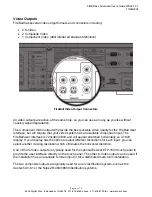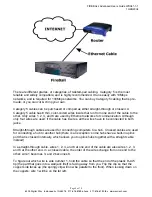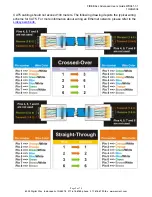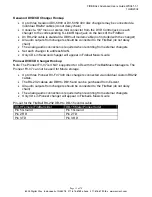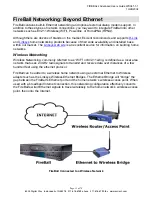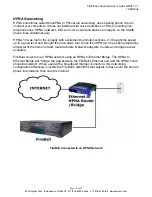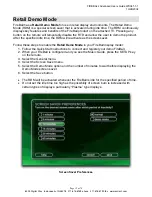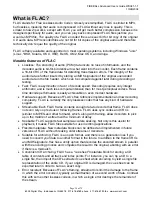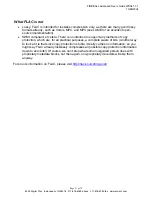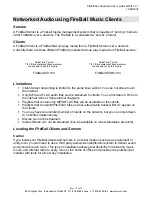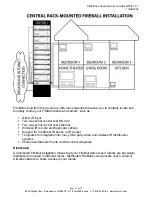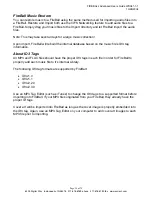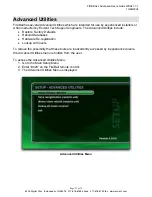
FIREBALL Advanced Users Guide WD041-1-1
10/26/2004
Page 20 of 70
6325 Digital Way Indianapolis, IN 46278 317.616.6789 phone 317.616.6790 fax www.escient.com
What is FLAC?
FLAC stands for Free Lossless Audio Codec. Grossly oversimplified, FLAC is similar to MP3,
but lossless, meaning that audio is compressed in FLAC without any loss in quality. This is
similar to how Zip works, except with FLAC you will get much better compression because it is
designed specifically for audio, and you can play back compressed FLAC files just like you
would an MP3 file. The quality of a FLAC encoded file is an exact bit for bit copy of the original
CD audio data. MP3 encoded files are not bit for bit copies of the original audio and therefore
technically don’t equal the quality of the original.
FLAC is freely available and supported on most operating systems, including Windows, "unix"
(Linux, *BSD, Solaris, OS X, IRIX), BeOS, OS/2, Mac OS X, and Amiga.
Notable features of FLAC
x
Lossless: The encoding of audio (PCM) data incurs no loss of information, and the
decoded audio is bit-for-bit identical to what went into the encoder. Each frame contains
a 16-bit CRC of the frame data for detecting transmission errors. The integrity of the
audio data is further insured by storing an MD5 signature of the original unencoded
audio data in the file header, which can be compared against later during decoding or
testing.
x
Fast: FLAC is asymmetric in favor of decode speed. Decoding requires only integer
arithmetic, and is much less compute-intensive than for most perceptual codecs. Real-
time decode performance is easily achievable on even modest hardware.
x
Hardware support: Because of FLAC's free reference implementation and low decoding
complexity, FLAC is currently the only lossless codec that has any kind of hardware
support.
x
Streamable: Each FLAC frame contains enough data to decode that frame. FLAC does
not even rely on previous or following frames. FLAC uses sync codes and CRCs
(similar to MPEG and other formats), which, along with framing, allow decoders to pick
up in the middle of a stream with a minimum of delay.
x
Seekable: FLAC supports fast sample-accurate seeking. Not only is this useful for
playback, it makes FLAC files suitable for use in editing applications.
x
Flexible metadata: New metadata blocks can be defined and implemented in future
versions of FLAC without breaking older streams or decoders
x
Suitable for archiving: FLAC is an open format, and there is no generation loss if you
need to convert your data to another format in the future. In addition to the frame CRCs
and MD5 signature, flac has a verify option that decodes the encoded stream in parallel
with the encoding process and compares the result to the original, aborting with an error
if there is a mismatch.
x
Convenient CD archiving: FLAC has a "cue sheet" metadata block for storing a CD
table of contents and all track and index points. For instance, you can rip a CD to a
single file, then import the CD's extracted cue sheet while encoding to yield a single file
representation of the entire CD. If your original CD is damaged, the cue sheet can be
exported later in order to burn an exact copy.
x
Error resistant: Because of FLAC's framing, stream errors limit the damage to the frame
in which the error occurred, typically a small fraction of a second worth of data. Contrast
this with some other lossless codecs, in which a single error destroys the remainder of
the stream.
Summary of Contents for Fireball E-2
Page 1: ......
Page 2: ......
Page 3: ......
Page 4: ......
Page 5: ......
Page 6: ......
Page 7: ......
Page 8: ......
Page 9: ......
Page 10: ......
Page 11: ......
Page 12: ......
Page 13: ......
Page 14: ......
Page 15: ......
Page 16: ......
Page 17: ......
Page 18: ......
Page 19: ......
Page 20: ......
Page 21: ......
Page 22: ......
Page 23: ......
Page 24: ......
Page 25: ......
Page 26: ......
Page 27: ......
Page 28: ......
Page 29: ......
Page 30: ......
Page 31: ......
Page 32: ......
Page 33: ......
Page 34: ......
Page 35: ......
Page 36: ......
Page 37: ......
Page 38: ......
Page 39: ......
Page 40: ......
Page 41: ......
Page 42: ......
Page 43: ......
Page 44: ......
Page 45: ......
Page 46: ......
Page 47: ......
Page 48: ......
Page 49: ......
Page 50: ......
Page 51: ......
Page 52: ......
Page 53: ......
Page 54: ......
Page 55: ......
Page 56: ......
Page 57: ......
Page 58: ......
Page 59: ......
Page 60: ......
Page 61: ......
Page 62: ......
Page 63: ......
Page 64: ......
Page 65: ......
Page 66: ......
Page 67: ......
Page 68: ......
Page 69: ......
Page 70: ......
Page 71: ......
Page 72: ......
Page 73: ......
Page 74: ......
Page 75: ......
Page 76: ......
Page 77: ......
Page 78: ......
Page 79: ......
Page 80: ......
Page 81: ......
Page 82: ......
Page 83: ......
Page 84: ......
Page 85: ......
Page 86: ......
Page 87: ......
Page 88: ......
Page 89: ......
Page 90: ......
Page 91: ......
Page 92: ......
Page 93: ......
Page 94: ......
Page 95: ......
Page 96: ......
Page 97: ......
Page 98: ......
Page 99: ......
Page 100: ......
Page 101: ......
Page 102: ......
Page 103: ......
Page 104: ......
Page 105: ......
Page 106: ......
Page 179: ......

